| |
Fall Comdex 2000 Reviewed
Fall Comdex is the largest computer trade show in North America and the seminal event in the industry, so naturally, I've just got to be there. Here are my observations, and news article submissions, from the trip.
Day one: Sunday, November 12, 2000
Getting to Las Vegas from Boston is considerably more of a chore than doing so was from Phoenix, but I now fly out of the nearby Providence airport, which has two interesting side effects: Fewer crowds and a much earlier wake time. But the flights were on time and not full, and I was able to answer almost 100 emails on the way, so it wasn't a total loss. And this year, I'm staying at the Las Vegas Hilton, which is right next to the main convention center, also a huge plus. But before I could even check in, I had to head over to the MGM Grand and get my Gates tickets. Because this year, finally, they did something right with keynote crowd control.
In the past, the Gates keynote was a disaster, with crowds pouring into too-small amphitheaters to hear the sultan of software strut his stuff. Over the years, I've seen Gates keynote Comdex six times and it's always been the same before the speech, regardless of the venue: Long waits, people jumping over rows of seats, and confusion. But this year, they moved the keynote to the MGM Grand Arena, which could easily host NBA basketball games, prizefights, or even a circus. And in addition to the ample seating, a first by any measure, they finally began assigning seats on a first come, first serve basis.
So when I arrived Sunday morning, I made my way over to the MGM ticket office to pick up my ticket. This allowed me relax later on, knowing that there was a seat waiting for me at the keynote. I've complained bitterly in the past about the way Comdex has treated people trying to see the keynote, so I should at least express some thanks here that they finally got it right. Someone was listening, I guess.
Given the venue, the Gates show promised to be a much bigger show than usual. Pre-speech, a gigantic image of Windows Media Player 7 was broadcast onto the main screen, pumping out music while a series of visualizations throbbed to the tunes. I mused about the taxi driver who had complained endlessly about Windows 98 on the way to MGM, though I don't think he quite understood that I didn't work for Microsoft when I tried to explain Windows 2000 Magazine to him. Oh well.
Vegas has changed, but of course Vegas never really changes. The old Aladdin--home to many a Gates keynote, incidentally--has been replaced by a newer version. The sprawling MGM compound now occupies an entire city block, it's most notable new addition being the Grand Arena that hosted this year's keynote. I'm not a huge fan of the city, I'm sorry to say--it's too loud and constant for me--but I've done this enough to be comfortable here, at least for a few days.
After an seemingly interminable wait, Gates finally took the stage.
COMDEX: Gates demos TabletPC, Office 10, VS.NET
COMDEX: Whistler to be named Windows 2001
Day two: Monday, November 13, 2000
After the Gates keynote Sunday night, I headed over to the press reception and ran into Microsoft president and CEO Steve Ballmer, who shook my hand, squinted as he looked down at my name badge (causing my heart to skip a beat, frankly) and then boomed, "HOW YA DOIN'?" He's such a nice, approachable guy. ClearType guru Bob Hill was also on hand, kilt and all, along with the Microsoft product manager who had demoed the TabletPC onstage with Gates at the keynote. He let me play around with the device for a while and noted that it was running on a Transmeta chip. Actual shipping devices--due in 2002 he said--could run on Intel, AMD, or whatever the PC makers wanted. That was their call. But the TabletPC is sweet, no doubt about it.
Other faces in the crowd: Dan Bricklin, Walter Mosberg, and the son of Ralph Lauren, who also participated in what was arguably the liveliest part of the keynote. Then Gates showed up and the crowds swarmed around him, presumably to hear him pontificate further on the subjects that were already broached in the keynote. He wasn't really saying anything of interest, so I headed out. After a brief stop at GeekFest, where I was required to wear Elvis sunglasses, I headed back to the room and crashed.
I ran into an interesting problem Monday, due to the three-hour time change from Boston to Las Vegas and what I take to be a bug in Microsoft Outlook. I had scheduled a number of meetings during my trip, including four for Monday afternoon. After breakfast, I jotted down the times and locations of my meetings--which I had saved in Outlook's Calendar module--and headed down to the main Convention Center, which is attached to the hotel at which I'm staying (ah, convenience). First stop was the Microsoft press room, which is in the same place it's always been, a rare second floor room overlooking the main show floor. Microsoft didn't have a map, however, so I headed out onto the floor to look around. According to my notes, my first meeting was at 11:00 a.m. with Lernought & Hauspie, makers of the voice dictation and command software.
I found the booth a lot more quickly than I thought I would, but then I realized that I had forgotten to write down the name of the person I'd be meeting with at L&H. So I sat down at a table in their booth (what the heck) and fired up the laptop. When I opened Outlook to the meeting, I noticed something odd: Despite the fact that it was marked down for 11:00, the text of the meeting schedule, which I had copied in full from an earlier email noted that the time I was to meet them was 2:00 p.m., not 11:00 a.m. Likewise, each of my further meetings was three hours off as well.
The culprit, of course, was the Time Zone settings in Windows, which I had changed on the flight to Vegas. But why the heck would Outlook have adjusted scheduled items according to the Time Zone? I'm going to ask someone on the Office team about that one. In the meantime, I had three hours to kill, and a crowded show floor to deal with. So I headed into the throng for a quick look at Microsoft's area.
Microsoft's Comdex presence has always been massive, but this year it's bigger than ever, spreading out into the booths that used to be next to it. It's a small city unto itself, with a PocketPC "hands-on lab" that drew numerous onlookers and a large number of theaters showing off Microsoft's present and upcoming products. Windows Me, the .NET Enterprise Servers, PocketPC, and Office were all being heavily promoted, and I noticed that Microsoft had begun referring to the Windows Me UI as a "new user experience," an interesting choice of words. I ran into Microsoft CEO and president Steve Ballmer for a second time in front of the hands-on lab and snapped a photo of the congenial guy. The fact that a guy like Ballmer can walk around a show as crowded as Comdex never ceases to amaze. I spent the rest of the time wandering around the south hall, and I'll have some show highlights in my next report. After that, it was time for a series of back-to-back meetings, most of them with Microsoft. It seems that the company had a few announcements of note that day.
COMDEX: Microsoft announces Office 10 subscription option
COMDEX: Microsoft releases new Media Player for the PocketPC
Microsoft: "Windows 2001" title was a misprint
Day three: Tuesday, November 14, 2000
After a rather exhausting series of meetings finally ended late Monday, I headed out from the Las Vegas Convention Center toward the Hilton. It's a lot colder than usual in Vegas this year, but that's appreciated, as it's usually unbearably hot, especially when you're carting around a laptop. I stepped into the side entrance of the Hilton and saw some commotion coming, along with security guards brushing people aside, yelling, "step aside, step aside." So what I see in the middle of this mess is a very bemused Larry Ellison, who seemed slyly happy at the reaction this was getting from the bystanders. An Oriental woman was whispering something important in his ear as they flew by, but Ellison just looked out over the gaping onlookers, smiling. And then they were gone. Weird.
Anyway, Monday night was Showstoppers, which has grown almost out of control. The concept is a good one: Smaller companies tend to get lost in the klaxon call that is Comdex, so a group of these companies gets together, rents a hall, and then invites the press in for free food, drinks, and product demos. Predictably, we're all over this, like flies on a bug light. Most respectable journalists aren't into cheap freebies like t-shirts and cheap plastic gadgets (ahem), but throw some shrimp and beer in front of us and we'll claw at each other like teenagers trying to get into a Brittney Spears concert. It's sort of humiliating, to be honest.
No matter, Showstoppers is good stuff and like I said, this year, it was bigger than ever. It was held in the newly reopened Alladin, which is now yet another modern themed casino on the strip. Belkin was on hand with some cool products, including a USB 2.0 card that will ship next Spring: This features five 400 Mb USB 2.0 connections (one internal), all fast enough to drive a hard drive or CDRW. Good stuff. PhotoWorks (the former Seattle Filmworks) was on hand as well and I highly recommend their services for digital and traditional SLR camera users. Stardock unveiled Object Desktop 2001, which combines their successful WindowsBlinds product with an amazing object-based desktop replacement that can make Windows look like just about anything. And ZoneLabs was talking up ZoneAlarm and ZoneAlarm Pro, a must for broadband users.
A couple of big companies such as Compaq and Intel were on hand as well, but I don't appreciate their presence at an event like this; it's like they're bullying their way into a kid's clubhouse or something. Companies like this can afford real booths the size of a city block, and of course that's exactly what they've got at the Convention Center, so it's unclear why they're here as well. What I'd like to see here are companies like Borland and Corel.
I spent some time talking with Linux Today's Michael Hall at Showstoppers. He's a cool guy, and I promised not to reveal the company's name, but I did watch as he bailed this unnamed company out of a jam by hacking into one of their Linux boxes to get their demo up and going again. Michael asked me if I had gotten any nasty emails from his readers, and I have (hey, the OS wars are still in full swing), but I told him that came with the territory, no problem. He seemed genuinely bothered by that, and told me he was sorry. Class act.
We talked a bit about the evolution of Linux and where it's going. I hope I surprised him by not being a complete Windows sycophant, and I honestly do try and stay up to speed on the latest Linux distributions. One interesting side-note: In the middle of his successful Linux rescue attempt, Alex Pournelle, son of famed sci-fi author and computer industry pundit Jerry Pournelle, and a writer in his own right, stopped by to offer technical assistance. It was only after he left that we realized that he was actually there for that reason. Michael and I sort of looked at the floor wondering what to think of this, and he finally said, "I guess he has to work somewhere."
After that, I finally went back to the room and crashed. The next morning, I woke up at 5:00, sat in front of the window in darkness finishing up WinInfo, and watched the sun come up. I'm not exactly a morning person, but the three-hour time change was working in my favor. I spent most of Tuesday morning running around the convention center, looking at exhibits. Franklin was showing off their new eBookman, which they hope to ship by the end of the year; it looks great. Intel had a tremendous Pentium 4 booth with lots of cool stuff, and I saw a wide range of future PC designs that showed some promise. Gateway surprised me with some cool new laptops that I wish I had known about three months ago. Iomega had a huge presence and was showing off its new Zip devices.
But in the main Convention Center hall, Microsoft is it. I actually sat through a few shows ("Top 10 cool hidden features in Office 2000," which was OK, and "Introduction to .NET," which was bloody awful and almost anti-informative). Crowds were thickest at the PocketPC booths, and the hands-on lab was continuously packed. I happened to stroll behind one of the PC-based hands-on labs and was bemused to see dozens of PCs all being rolled back to a pristine state with Norton Ghost. I guess the days of Microsoft not supporting that product are officially over.
Tuesday afternoon, I picked up the code for Office 10 from the Microsoft press room, found a corner somewhere, sat down, and installed it. I'll have a review later this week, and some cool showcases after that. I'm really excited about Office 10, and I think that this may be an upgrade to look forward to. I also inquired about Visual Studio.NET, but they're going to be sending me that later on, as the code hadn't arrived yet from Redmond. I'll be reviewing that as well. I sat down with some Small Business Server 2000 program managers late Tuesday: That product is just about done, and they're only waiting on ISA Server. Microsoft expects both of those products to go gold by the end of the year.
The one thing that's a bit odd about this year's Comdex is that there weren't any major product announcements at all. Microsoft is basically between products, so to speak, and the only release to speak of is Netscape 6, from AOL, and I haven't heard anyone speak too positively about that.
And that's about it. I have a couple of events I could've attended Tuesday night, but my flight leaves oh too early in the morning on Wednesday, and I've got some work to do, including a few reports on some announcements made today.
COMDEX: Microsoft preps online collaboration tool
COMDEX: Intel to launch Pentium 4 next week
COMDEX wrap-up
I'm home, finally, and exhausted of course. Comdex is a rush unparalleled in the computing industry, with competing visions of the future pounding at you from all directions. It's an overload of sights and sounds, no doubt about it. But the most striking thing about Comdex this year, I guess, was that there were no huge new product releases. Most companies, including Microsoft, seemed to be "between releases," as I mentioned before, though there were an interesting number of future PC designs here and there. Intel is set to release the Pentium 4, but we've known about that for months. And wireless products, of course, were everywhere, and everyone was talking about 802.11 and Personal Area Networks (PAN). But I have to agree with Bill Gates in this case: The PC is going to change, perhaps dramatically, but it isn't going away. And the amazing rush of PC companion products--PDAs, set-top boxes, etc.--will do nothing to diminish its importance.
For whatever it's worth, I'm pretty excited about the next generation of Microsoft's platform products. Windows 2002/Windows.NET/Whistler/whatever is looking good, as is Office 2002/10, which answers one major complaint about the suite by bringing hidden functionality to the surface in a way that is logical and unobtrusive. And Visual Studio.NET, which shipped in Beta 1 form while I was in Vegas, is the key to getting developers onboard the .NET train. Comparing Microsoft's presence at the show with the Linux bargain basement over at the Sands is, of course, unfair. Look to Linux to finally get out of the "almost as good as Windows" category and begin offering some real innovations in 2001. The time for catch-up is almost over.
|
|
Scenes from Comdex
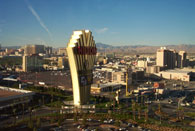 I somehow managed to get one of the best rooms in Vegas: This was the view.
I somehow managed to get one of the best rooms in Vegas: This was the view.
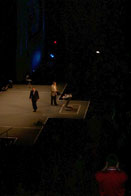
The Gates keynote... from the cheap seats.
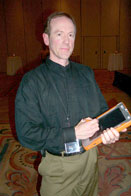
Microsoft product manager Bert Keely shows off the Tablet PC at the press reception after the Gates keynote. Yes, it's very cool.
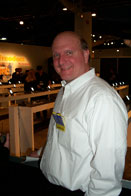
My second run-in with Microsoft CEO and president Steve Ballmer yielded this photo-op. He's a great guy.
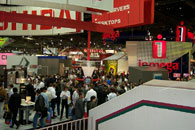 Scenes from the show: The throng piles through the south hall of the Las Vegas Convention Center.
Scenes from the show: The throng piles through the south hall of the Las Vegas Convention Center.
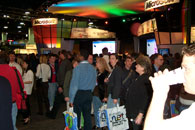 Microsoft's booth was continually packed.
Microsoft's booth was continually packed.
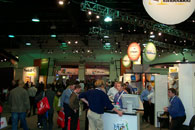 A small city unto itself, Microsoft's area offered theaters, info booths, and partner pavilions.
A small city unto itself, Microsoft's area offered theaters, info booths, and partner pavilions.
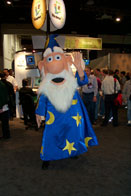
Merlin, the Microsoft Agent, was out and about.
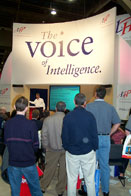
L&H was showing off its voice dictation and command software.
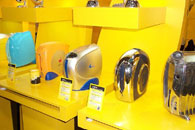 Cool new PC designs were all over. Expect to see designs like this on mainstream PCs in two years.
Cool new PC designs were all over. Expect to see designs like this on mainstream PCs in two years.
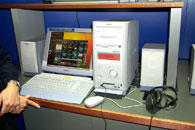 Sony was showing off this prototype of a future PC design.
Sony was showing off this prototype of a future PC design.
|

